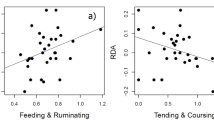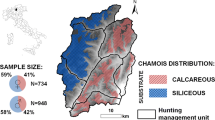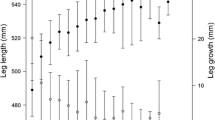Abstract
Secondary sexual traits in males of polygynous species are important determinants of reproductive success. It is, however, unknown if and how the development of continuously growing traits at different life-stages is related to reproduction in long-lived male mammals. In this study, we evaluated the relationship of early and late horn growth on social status and reproduction in long-lived male Alpine ibex (Capra ibex). For this, we analysed individual horn growth and assessed its effect on dominance and reproduction. No evidence was detected for compensatory horn growth, as late-life horn growth positively depended on early-life horn growth in males. Still, individuals with longer horn segments grown during early adulthood experienced a stronger age-dependent length decline in annual horn growth during the late development. Accordingly, a divergence between individual growth potential and realized horn growth late in life has to be assumed. Residual age-specific horn length and length of early grown horn segments both positively affected dominance and reproductive success, whereas, contrary to our expectation, no significant effect of the length of horn segments grown during the late development was detected. Suspected higher somatic costs incurred by high-quality males during their late development might at least partly be responsible for this finding. Overall, our study suggests that the total length of horns and their early development in long-lived male Alpine ibex is a reliable indicator of reproductive success and that individuals may be unable to compensate for poor early-life growth performance at a later point in life.






Similar content being viewed by others
References
Adams, E. S. (2005). Bayesian analysis of linear dominance hierarchies. Animal Behaviour, 69, 1191–1201.
Alvarez, F. (1990). Horns and fighting in male Spanish ibex, Capra pyrenaica. Journal of Mammalogy, 71(4), 608–616.
Andersson, M. (Ed.). (1994). Sexual selection (pp. 1–599). Princeton: Princeton University Press.
Appleby, M. C. (1982). The consequences and causes of high social rank in red deer stags. Behaviour, 80, 259–273.
Bassano, B., Perrone, A., & Von Hardenberg, A. (2003). Body weight and horn development in Alpine chamois, Rupicapra rupicapra (Bovidae, Caprinae). Mammalia, 67(1), 65–73.
Beauplet, G., & Guinet, C. (2007). Phenotypic determinants of individual fitness in female fur seals: Larger is better. Proceedings of the Royal Society B-Biological Sciences, 274(1620), 1877–1883.
Bergeron, P., Festa-Bianchet, M., von Hardenberg, A., & Bassano, B. (2008). Heterogeneity in male horn growth and longevity in a highly sexually dimorphic ungulate. Oikos, 117(1), 77–82.
Bergeron, P., Grignolio, S., Apollonio, M., Shipley, B., & Festa-Bianchet, M. (2010). Secondary sexual characters signal fighting ability and determine social rank in Alpine ibex (Capra ibex). Behavioral Ecology and Sociobiology, 64, 1299–1307.
Bro-Jørgensen, J. (2002). Overt female mate competition and preference for central males in a lekking antelope. Proceedings of the National Academy of Sciences of the United States of America, 99(14), 9290–9293.
Bro-Jørgensen, J. (2007). Reversed sexual conflict in a promiscuous antelope. Current Biology, 17(24), 2157–2161.
Buentgen, U., Liebhold, A., Jenny, H., Mysterud, A., Egli, S., Nievergelt, D., et al. (2014). European springtime temperature synchronises ibex horn growth across the eastern Swiss Alps. Ecology Letters, 17(3), 303–313.
Caro, T. M., Graham, C. M., Stoner, C. J., & Flores, M. M. (2003). Correlates of horn and antler shape in bovids and cervids. Behavioral Ecology and Sociobiology, 55(1), 32–41.
Clutton-Brock, T. H., Albon, S. D., & Guinness, F. E. (1988a). Reproductive success in male and female red deer. In T. H. Clutton-Brock (Ed.), Reproductive success (pp. 325–343). Studies of individual variation in contrasting breeding systems. Chicago: The University of Chicago Press.
Clutton-Brock, T. H., Green, D., Hiraiwa-Hasegawa, M., & Albon, S. D. (1988b). Passing the buck: Resource defence, lek breeding and mate choice in fallow deer. Behavioral Ecology and Sociobiology, 23, 281–296.
Clutton-Brock, T. H., Guinness, F. E., & Albon, S. D. (1982). Red deer. Behavior and ecology of two sexes. Chicago: The University of Chicago Press.
Coltman, D. W., Festa-Bianchet, M., Jorgenson, J. T., & Strobeck, C. (2002). Age-dependent sexual selection in bighorn rams. Proceedings of the Royal Society of London Series B-Biological Sciences, 269(1487), 165–172.
Côté, S. D., Festa-Bianchet, M., & Smith, K. G. (1998). Horn growth in mountain goats (Oreamnos americanus). Journal of Mammalogy, 79(2), 406–414.
Emlen, D. J. (2008). The evolution of animal weapons (pp. 387–413). Annual Reviews: Annual Review Of Ecology Evolution And Systematics. Palo Alto.
Festa-Bianchet, M., Coltman, D. W., Turelli, L., & Jorgenson, J. T. (2004). Relative allocation to horn and body growth in bighorn rams varies with resource availability. Behavioral Ecology, 15(2), 305–312.
Giacometti, M., Willing, R., & Defila, C. (2002). Ambient temperature in spring affects horn growth in male alpine ibexes. Journal of Mammalogy, 83(1), 245–251.
Hadfield, J. D., Richardson, D. S., & Burke, T. (2006). Towards unbiased parentage assignment: Combining genetic, behavioural and spatial data in a Bayesian framework. Molecular Ecology, 15(12), 3715–3730.
Hogg, J. T., & Forbes, S. H. (1997). Mating in bighorn sheep: Frequent male reproduction via a high-risk “unconventional” tactic. Behavioral Ecology and Sociobiology, 41(1), 33–48.
Jennings, D. J., Gammell, M. P., Carlin, C. M., & Hayden, T. J. (2006). Is difference in body weight, antler length, age or dominance rank related to the number of fights between fallow deer (Dama dama)? Ethology, 112(3), 258–269.
Kruuk, L. E. B., Clutton-Brock, T. H., Rose, K. E., & Guinness, F. E. (1999). Early determinants of lifetime reproductive success differ between the sexes in red deer. Proceedings of the Royal Society of London Series B-Biological Sciences, 266(1429), 1655–1661.
Kruuk, L. E. B., Slate, J., Pemberton, J. M., Brotherstone, S., Guinness, F., & Clutton-Brock, T. (2002). Antler size in red deer: Heritability and selection but no evolution. Evolution, 56(8), 1683–1695.
Loison, A., Gaillard, J. M., Pelabon, C., & Yoccoz, N. G. (1999). What factors shape sexual size dimorphism in ungulates? Evolutionary Ecology Research, 1(5), 611–633.
Lüps, P., Blöchlinger, B., Schmid, P., & Zuber, M. (2007). Ontogenese und Variabilität verschiedener Körpermerkmale des Steinwildes Capra i. ibex im Berner Oberland (Schweizer Alpen). Beiträge zur Jagd- und Wildforschung, 32, 495–510.
McElligott, A. G., Naulty, F., Clarke, W. V., & Hayden, T. J. (2003). The somatic cost of reproduction: What determines reproductive effort in prime-aged fallow bucks? Evolutionary Ecology Research, 5(8), 1239–1250.
Møller, A. P. (1989). Viability costs of male tail ornaments in a swallow. Nature, 339(6220), 132–135.
Pinheiro, J. C., & Bates, D. M. (2000). Mixed-effects models in S-Plus. New York: Springer Verlag.
Preston, B. T., Stevenson, I. R., Pemberton, J. M., & Wilson, K. (2001). Dominant rams lose out by sperm depletion: A waning success in siring counters a ram’s high score in competition for ewes. Nature, 409(6821), 681–682.
Robinson, M. R., Pilkington, J. G., Clutton-Brock, T. H., Pemberton, J. M., & Kruuk, L. E. B. (2008). Environmental heterogeneity generates fluctuating selection on a secondary sexual trait. Current Biology, 18(10), 751–757.
Romero, T., & Castellanos, M. A. (2010). Dominance relationships among male hamadryas baboons (Papio hamadryas). Journal of Ethology, 28(1), 113–121.
Shuster, S. M., & Wade, M. J. (2003). Mating systems and strategies. Princeton: Princeton University Press.
Spiegelhalter, D., Thomas, A., Best, N., & Lunn, D. (2003). WinBUGS. User manual, version 1.4. Cambridge: MRC Biostatistics Unit.
Stearns, S. C. (1992). The evolution of life histories. New York: Oxford University Press.
Stevenson, I. R., Marrow, P., Preston, B. T., Pemberton, J. M., & Wilson, K. (2004). Adaptive reproductive strategies. In J. Pemberton & T. H. Clutton-Brock (Eds.), Soay sheep. Dynamics and selection in a island population. Cambridge: Cambrigde University Press.
Toïgo, C., Gaillard, J. M., Festa-Bianchet, M., Largo, E., Michallet, J., & Maillard, D. (2007). Sex- and age-specific survival of the highly dimorphic Alpine ibex: Evidence for a conservative life-history tactic. Journal of Animal Ecology, 76(4), 679–686.
Toïgo, C., Gaillard, J.-M., & Loison, A. (2013). Alpine ibex males grow large horns at no survival cost for most of their lifetime. Oecologia, 173(4), 1261–1269.
Toïgo, C., Gaillard, J. M., & Michallet, J. (1999). Cohort affects growth of males but not females in alpine ibex (Capra ibex ibex). Journal of Mammalogy, 80(3), 1021–1027.
Vanpé, C., Gaillard, J.-M., Kjellander, P., Liberg, O., Delorme, D., & Hewison, A. J. M. (2010). Assessing the intensity of sexual selection on male body mass and antler length in roe deer Capreolus capreolus: Is bigger better in a weakly dimorphic species? Oikos, 119(9), 1484–1492.
Vanpé, C., Gaillard, J.-M., Kjellander, P., Mysterud, A., Magnien, P., Delorme, D., et al. (2007). Antler size provides an honest signal of male phenotypic quality in roe deer. American Naturalist, 169(4), 481–493.
Vanpé, C., Morellet, N., Kjellander, P., Goulard, M., Liberg, O., & Hewison, A. J. M. (2009). Access to mates in a territorial ungulate is determined by the size of a male’s territory, but not by its habitat quality. Journal of Animal Ecology, 78(1), 42–51.
von Hardenberg, A., Bassano, B., Festa-Bianchet, M., Luikart, G., Lanfranchi, P., & Coltman, D. (2007). Age-dependent genetic effects on a secondary sexual trait in male Alpine ibex, Capra ibex. Molecular Ecology, 16(9), 1969–1980.
Willisch CS. 2009. The ecology of reproduction in long-lived male Alpine ibex (Capra ibex): The role of age, dominance and alternative mating tactics. [PhD thesis]. Neuchâtel: Université de Neuchâtel. 1-106 p.
Willisch, C. S., Biebach, I., Koller, U., Bucher, T., Marreros, N., Ryser-Degiorgis, M.-P., et al. (2012). Male reproductive pattern in a polygynous ungulate with a slow life-history: The role of age, social status and alternative mating tactics. Evolutionary Ecology, 26(1), 187–206.
Willisch, C. S., Marreros, N., & Neuhaus, P. (2013). Long-distance photogrammetric trait estimation in free-ranging animals: A new approach. Mammalian Biology, 78, 351–355.
Willisch, C. S., & Neuhaus, P. (2009). Alternative mating tactics and their impact on survival in adult male Alpine ibex (Capra ibex ibex). Journal of Mammalogy, 90(6), 1421–1430.
Willisch, C. S., & Neuhaus, P. (2010). Social dominance and conflict reduction in rutting male Alpine ibex Capra ibex. Behavioral Ecology, 21(321), 380.
Zahavi, A. (1975). Mate selection: A selection for a handicap. Journal of Theoretical Biology, 53(1), 205–214.
Acknowledgments
We thank J.-C. Roch, K. Bieri Willisch, T. Bucher, P. Decristophoris, P. Deleury, I. Glanzmann, N. Grandjean, C. Hebeisen, B. Hofer, U. Koller, I. Leathwood, H. Nimmervoll, B. Nussberger, L. Senn, C. Wittker, M. Pewsner, and numerous volunteers for their help with the captures, data collection and laboratory work. We are grateful to L. Keller, J. Hadfield, E. Postma and P. Wandeler for their assistance with genetic and statistical analyses. For valuable comments on earlier drafts of this manuscript we thank M. Festa-Bianchet, V. Hayssen and an anonymous referee. Many thanks go to the authorities of the Canton Vaud and the Swiss Federal Office of the Environment FOEN. The study was financed by the FOEN.
Author information
Authors and Affiliations
Corresponding author
Rights and permissions
About this article
Cite this article
Willisch, C.S., Biebach, I., Marreros, N. et al. Horn Growth and Reproduction in a Long-Lived Male Mammal: No Compensation for Poor Early-Life Horn Growth. Evol Biol 42, 1–11 (2015). https://doi.org/10.1007/s11692-014-9294-3
Received:
Accepted:
Published:
Issue Date:
DOI: https://doi.org/10.1007/s11692-014-9294-3




